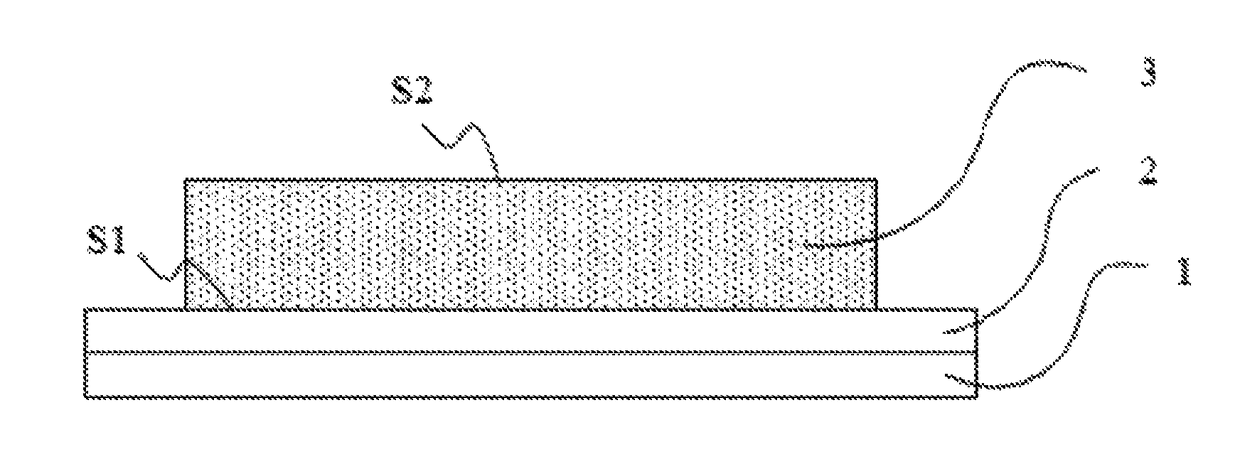Diffuse reflection material, diffuse reflection layer, wavelength conversion device and light source system
a technology of diffuse reflection and diffuse material, which is applied in the direction of diffusing elements, lighting and heating apparatus, instruments, etc., can solve the problems of nigrescence of mirror silver/aluminum, adverse to and thermal resistance, so as to improve the thermostability of wavelength conversion devices and improve the reflective index of diffuse reflection materials
- Summary
- Abstract
- Description
- Claims
- Application Information
AI Technical Summary
Benefits of technology
Problems solved by technology
Method used
Image
Examples
example 1
[0050]Raw materials: 0.1 g of aluminum oxide (spherical, with a particle diameter of 0.2 μm), 0.6 g of titanium oxide (spherical, with a particle diameter of 0.2 μm), 0.4 g of boron nitride (flat, with a length in the flat direction of 0.7 μm, and a length in the thickness direction of 0.02 μm), and 1 g of glass powder.
[0051]Preparation method: aluminum oxide, titanium dioxide, and boron nitride as well as the glass powder and 1 g of organic carrier (which was terpineol, butyl carbitol acetate, ethyl cellulose) were mixed to form a mixed material; the mixed material was blade coated onto an aluminum nitride substrate surface and sintered at 800° C.; and the steps of blade coating and sintering were repeated to form a diffuse reflection layer with a thickness of 30 μm, which was determined to have a reflective index of 92.4%.
example 2
[0052]Raw materials: 0.08 g of magnesium oxide (spherical, with a particle diameter of 0.3 μm), 0.7 g of zirconium oxide (spherical, with a particle diameter of 0.3 μm), 0.3 g of aluminum nitride (rod-like, with a length in the length direction of 1.0 μm, and a diameter length in the peripheral direction of 0.02 μm), and 1 g of glass powder.
[0053]Preparation method: the above magnesium oxide, zirconium oxide, and aluminum nitride as well as the glass powder and 1 g of organic carrier (which was a solution of PVA in water) were mixed to form a mixed material; the mixed material was blade coated onto a silicon nitride substrate surface and sintered at 600° C.; the steps of blade coating and sintering were repeated to form a diffuse reflection layer with a thickness of 30 μm, which was determined to have a reflective index of 90.8%.
example 3
[0054]Raw materials: 0.08 g of barium sulfate (spherical, with a particle diameter of 0.5 μm), 0.5 g of zinc oxide (spherical, with a particle diameter of 0.5 μm), 0.3 g of aluminum nitride (flat, with a length in the flat direction of 2.5 μm, and a length in the thickness direction of 0.1 μm), and 1 g of glass powder.
[0055]Preparation method: the above barium sulfate, zinc oxide, and aluminum nitride as well as the glass powder and 2.5 g of organic carrier (which was formed by dissolving ethyl cellulose into a mixed solvent of terpineol and acetyl tributyl citrate) were mixed to form a mixed material; the mixed material was blade coated onto a boron nitride substrate surface and sintered at 1000° C.; and the steps of blade coating and sintering were repeated to form a diffuse reflection layer with a thickness of 30 μm, which was determined to have a reflective index of 91.3%.
PUM
| Property | Measurement | Unit |
|---|---|---|
| refractive index | aaaaa | aaaaa |
| radius | aaaaa | aaaaa |
| length | aaaaa | aaaaa |
Abstract
Description
Claims
Application Information
 Login to View More
Login to View More - R&D
- Intellectual Property
- Life Sciences
- Materials
- Tech Scout
- Unparalleled Data Quality
- Higher Quality Content
- 60% Fewer Hallucinations
Browse by: Latest US Patents, China's latest patents, Technical Efficacy Thesaurus, Application Domain, Technology Topic, Popular Technical Reports.
© 2025 PatSnap. All rights reserved.Legal|Privacy policy|Modern Slavery Act Transparency Statement|Sitemap|About US| Contact US: help@patsnap.com


